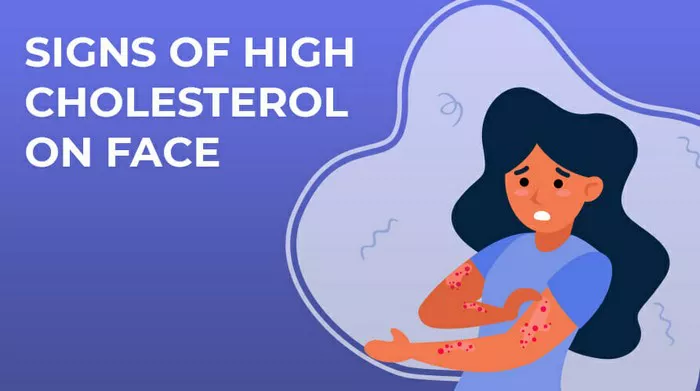High cholesterol levels can have a significant impact on various aspects of health, including the appearance of the skin on the face. While cholesterol is essential for building cells and producing certain hormones, excess cholesterol in the blood can lead to health problems, including visible signs on the face. Understanding these signs can be crucial for early detection and management of high cholesterol levels. In this article, we will explore the signs of high cholesterol on the face, their causes, and potential treatments.
1. Xanthelasma
One of the most noticeable signs of high cholesterol on the face is the presence of xanthelasma. Xanthelasma are yellowish patches that develop under the skin, typically around the eyelids. These patches are caused by the accumulation of cholesterol deposits in the skin and are often a sign of elevated cholesterol levels in the blood. Xanthelasma may not cause any discomfort but can be a cosmetic concern for many individuals.
2. Yellowish Skin Tone
High cholesterol levels can also contribute to a yellowish tint or discoloration of the skin on the face. This yellowish tone, known as jaundice, occurs when there is a buildup of bilirubin in the blood. Bilirubin is a yellow pigment produced when red blood cells break down. Elevated cholesterol levels can affect liver function, leading to an increase in bilirubin levels and the development of jaundice.
3. Cholesterol Deposits Around the Eyes
In addition to xanthelasma, high cholesterol can also cause cholesterol deposits to form around the eyes. These deposits may appear as small, yellowish bumps or plaques on the skin. They are often more prominent in individuals with familial hypercholesterolemia, a genetic condition characterized by high cholesterol levels from a young age. Cholesterol deposits around the eyes can be a visible indicator of underlying cholesterol issues.
4. Skin Tags
Skin tags are small, soft growths that can develop on the skin, including the face. While not directly caused by high cholesterol, individuals with elevated cholesterol levels may be more prone to developing skin tags. These growths can vary in size and often occur in areas where the skin folds or rubs together. Although skin tags are generally harmless, they can be a cosmetic concern and may indicate an underlying health condition such as high cholesterol.
5. Pale or Greyish Skin
Another possible sign of high cholesterol on the face is a pale or greyish skin tone. This change in skin coloration may be due to reduced blood flow or circulation caused by cholesterol buildup in the blood vessels. Poor circulation can affect the delivery of oxygen and nutrients to the skin, leading to a dull, pale appearance. In some cases, the skin may also appear mottled or uneven in texture.
6. Pruritus
Pruritus, or itching of the skin, can also be associated with high cholesterol levels. Elevated cholesterol can contribute to dry skin, which may become itchy and irritated. Pruritus can affect various areas of the body, including the face, and may be exacerbated by other factors such as weather conditions or skin care products. Managing cholesterol levels and maintaining proper skin hydration can help alleviate pruritus symptoms.
7. Increased Risk of Skin Infections
Individuals with high cholesterol levels may be at an increased risk of developing skin infections on the face and other areas of the body. High cholesterol can weaken the immune system and impair the skin’s ability to fight off infections. Common skin infections that may occur include bacterial infections, fungal infections, and viral infections such as cold sores. Proper hygiene and skincare practices are essential for reducing the risk of skin infections.
Causes of High Cholesterol on Face
Several factors can contribute to high cholesterol levels and the development of visible signs on the face. These include:
1. Diet: Consuming a diet high in saturated fats, trans fats, and cholesterol can increase LDL (bad) cholesterol levels in the blood.
2. Obesity: Being overweight or obese can lead to elevated cholesterol levels and increase the risk of developing xanthelasma and other cholesterol-related skin issues.
3. Genetics: Familial hypercholesterolemia and other genetic conditions can cause inherited high cholesterol levels, leading to early onset of xanthelasma and cholesterol deposits.
4. Lifestyle Factors: Lack of physical activity, smoking, excessive alcohol consumption, and stress can all contribute to high cholesterol levels and impact skin health.
Treatment and Management
Managing high cholesterol levels and addressing associated skin issues on the face requires a comprehensive approach that includes:
1. Dietary Changes: Adopting a heart-healthy diet rich in fruits, vegetables, whole grains, and lean proteins while limiting saturated fats, trans fats, and cholesterol-containing foods.
2. Regular Exercise: Engaging in regular physical activity can help lower LDL cholesterol levels, improve circulation, and support overall skin health.
3. Medication: In some cases, medications such as statins may be prescribed to help lower cholesterol levels and reduce the risk of cardiovascular disease.
4. Skincare Practices: Maintaining good skincare habits, including gentle cleansing, moisturizing, and protecting the skin from sun damage, can help improve the appearance of xanthelasma and other cholesterol-related skin issues.
5. Monitoring: Regular monitoring of cholesterol levels through blood tests and follow-up appointments with healthcare providers is essential for tracking progress and making necessary adjustments to treatment plans.
In conclusion, high cholesterol levels can manifest in various signs on the face, including xanthelasma, yellowish skin tone, cholesterol deposits, skin tags, pale or greyish skin, pruritus, and increased risk of skin infections. Understanding these signs, their causes, and appropriate management strategies is key to promoting overall health and well-being. Consulting with healthcare professionals for personalized guidance and treatment is recommended for individuals with concerns about high cholesterol and its impact on the skin.


